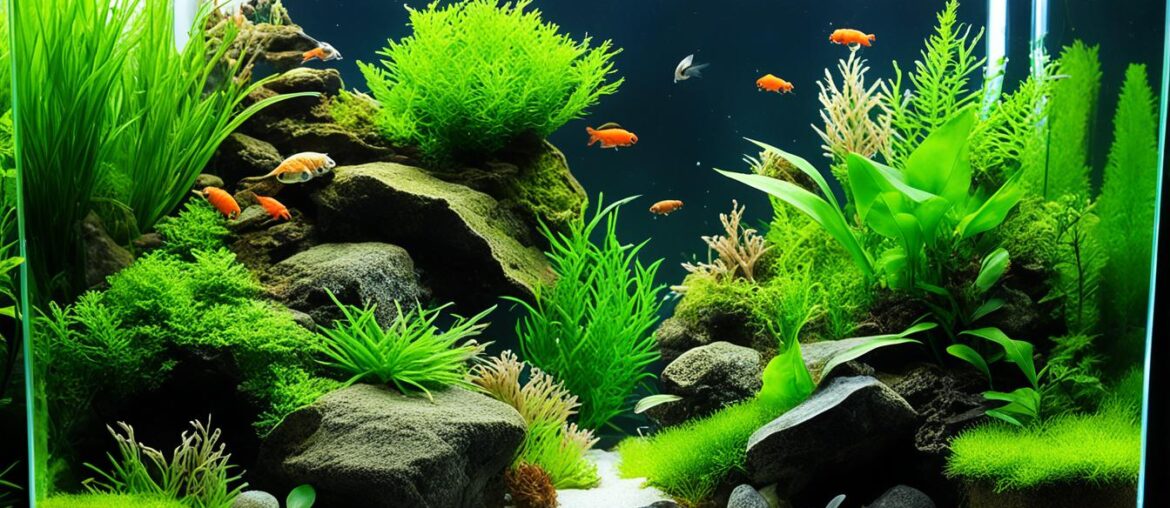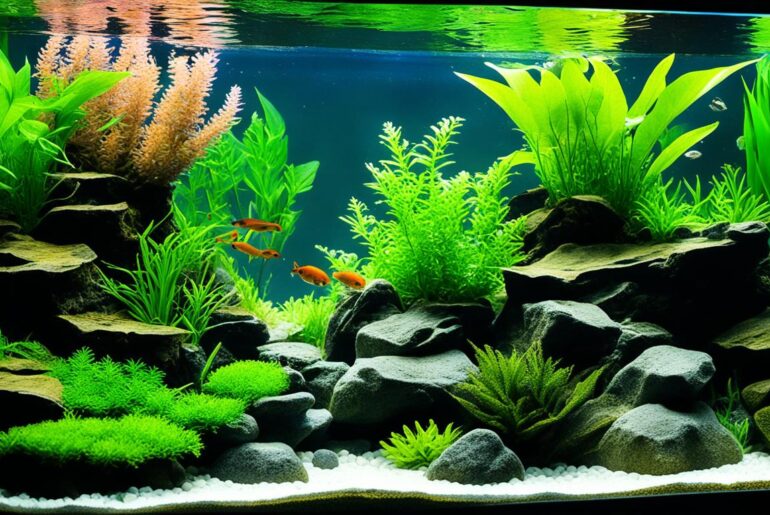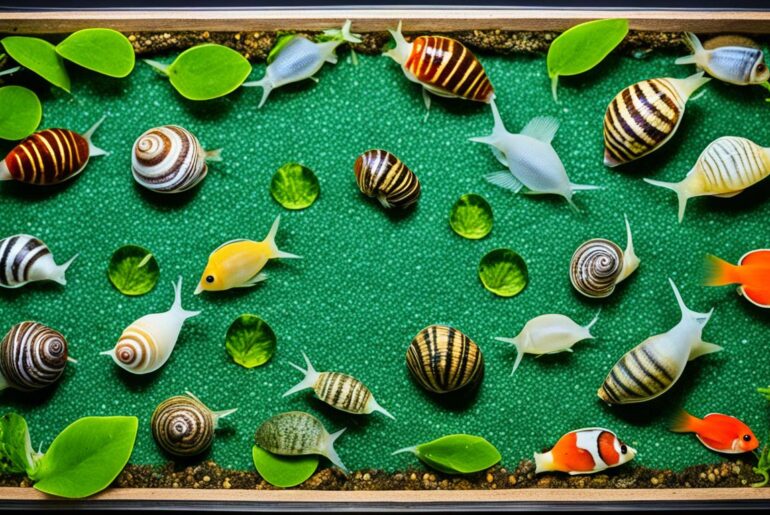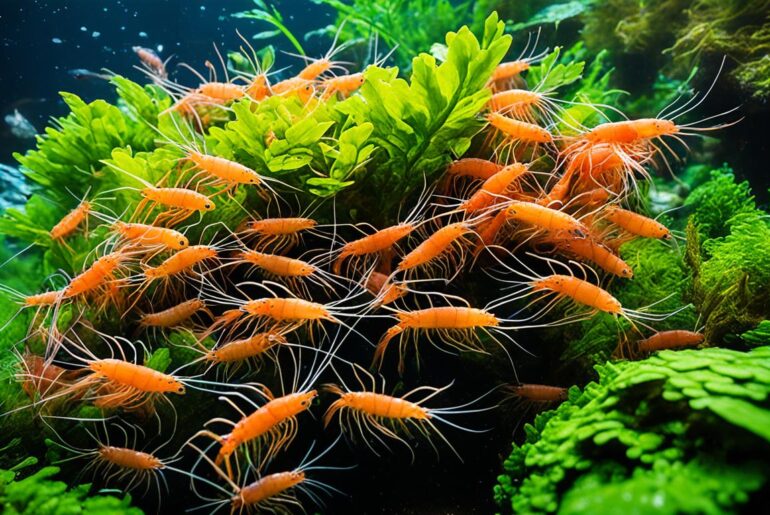When it comes to setting up a small tank, many aquarists focus on choosing the right fish. But have you ever considered adding freshwater invertebrates to your tank? These tiny creatures can bring a whole new level of beauty and diversity to your aquarium. But how do you choose the best freshwater invertebrates for small tanks, and what care do they require?
In this comprehensive guide, we’ll explore the world of small tank invertebrates and provide you with all the information you need to make the best choices for your aquarium. From understanding their specific needs to selecting compatible tankmates, we’ll cover it all. Get ready to discover the wonders of freshwater invertebrates and create a thriving underwater ecosystem in your small tank!
Key Takeaways:
- Choosing the right freshwater invertebrates can enhance the beauty and diversity of your small tank.
- Consider the specific needs and behaviors of each invertebrate species before making a decision.
- Research compatibility with other tank inhabitants and select suitable tankmates.
- Provide adequate equipment, maintain proper water conditions, and offer a balanced diet for their care.
- Regularly monitor the health and well-being of your invertebrates, seeking guidance when needed.
Questions to Ask When Choosing Fish
When it comes to choosing fish for a small tank, there are several important questions that need to be considered. These questions will help you make informed decisions and ensure that the fish you choose are compatible with your tank and meet their specific requirements.
Potential Size
One of the first things to consider is the potential size of the fish. It’s important to choose fish that will comfortably fit in your small tank without outgrowing their space. This will help prevent overcrowding and ensure the well-being of your fish.
Compatibility
Compatibility with other tank inhabitants is another crucial factor to consider. Some fish species are more aggressive and may not get along well with others. It’s essential to research and choose fish that will coexist peacefully with the other fish or organisms in your tank.
Territorial Behavior
Understanding the territorial behavior of your chosen fish is important to avoid conflicts. Some species are known to be territorial and may become aggressive towards other fish that encroach on their designated space. Ensuring that the fish you choose are compatible in terms of territorial behavior will help maintain a harmonious tank environment.
Dietary Requirements
Each fish species has specific dietary needs. It’s essential to choose fish that have similar dietary requirements to ensure they can be adequately nourished in your small tank. This will help prevent nutritional deficiencies and promote the overall health of your fish.
Water Parameters
Fish have specific water parameter requirements, such as temperature and pH levels. It’s important to select fish that can thrive within the water conditions you can provide in your small tank. This will help create a stable and healthy environment for your fish.
Availability and Cost
Before making a final decision, it’s a good idea to check the availability and cost of the fish species you are interested in. Some fish may be harder to find or more expensive than others. Considering these factors will help you decide if a particular fish is suitable for your small tank.
Group or Solo Fish
Some fish species thrive in groups, while others are better off being kept alone. Considering whether a fish should be kept in a group or as a solo fish will help you ensure their well-being and happiness in your small tank.
By asking these questions and doing thorough research, you can narrow down your choices and select the best fish for your small tank. Remember, choosing fish that are appropriate for your tank size and compatible with other tank inhabitants will lead to a beautiful and thriving aquarium.
| Question | Considerations |
|---|---|
| Potential Size | Choose fish that won’t outgrow your tank. |
| Compatibility | Select fish that will coexist peacefully with other tank inhabitants. |
| Territorial Behavior | Avoid fish that exhibit aggressive territorial behavior. |
| Dietary Requirements | Ensure the fish have similar dietary needs. |
| Water Parameters | Choose fish that can thrive in your tank’s water conditions. |
| Availability and Cost | Check the availability and cost of the fish species. |
| Group or Solo Fish | Determine if the fish should be kept in a group or alone. |
Seven Categories of Aquarium Fish
When it comes to choosing fish for your small tank, it’s essential to consider the different categories of aquarium fish available. Understanding these categories will help you make informed decisions about the best fish species for your tank.
The seven main categories of aquarium fish are:
- Catfish
- Characiforms
- Cichlids
- Cypriniforms
- Cyprinodonts
- Labyrinth fish
- Rainbowfish
Each category encompasses a wide variety of fish species, each with its own unique traits and characteristics. It’s crucial to research and understand the specific needs and behaviors of the fish within each category before making a decision.
To give you a better idea of what each category encompasses, here’s a brief overview:
| Category | Description |
|---|---|
| Catfish | These fish have barbels and are known for their scavenging behavior. They come in various sizes, from small species suitable for small tanks to large ones requiring more space. |
| Characiforms | Characiforms include popular fish such as tetras and hatchetfish. They are known for their vibrant colors and peaceful nature, making them great community tank inhabitants. |
| Cichlids | Cichlids are a diverse group of fish with various sizes, colors, and behaviors. Some are suitable for small tanks, while others require larger setups. |
| Cypriniforms | Cypriniforms include fish like danios and rasboras. They are generally small in size and known for their active nature, making them a great addition to small tanks. |
| Cyprinodonts | Cyprinodonts, also known as killifish, are colorful and unique fish. They come in various sizes and have different dietary needs and behaviors. |
| Labyrinth fish | Labyrinth fish are known for their labyrinth organ, which allows them to breathe air from the water’s surface. Betta fish are a popular example of labyrinth fish. |
| Rainbowfish | Rainbowfish are known for their vibrant colors and peaceful temperament. They are generally small to medium-sized fish and require adequate swimming space. |
By familiarizing yourself with the different categories and their characteristics, you can select fish that are compatible with your small tank and provide them with the best care possible.
With this knowledge at your fingertips, you can create a beautiful and harmonious aquarium filled with tropical fish species suited for small tanks.
Freshwater Dwarf Shrimp for Small Tanks
Freshwater dwarf shrimp can be a great addition to small tanks. They are low-maintenance and can cohabitate with fish or be kept in shrimp-only tanks. The two main genuses of freshwater shrimp are Neocaridina and Caridina. Neocaridina species, such as Red Cherry Shrimp, are hardy, adaptable, and ideal for beginners. Caridina species, like Crystal Red Shrimp, are more sensitive and require more precise care. It is essential to consider the specific water parameters and compatibility of each shrimp species before adding them to your small tank.
| Shrimp Species | Genus | Level of Care | Water Parameters | Compatibility |
|---|---|---|---|---|
| Red Cherry Shrimp | Neocaridina | Easy | Temperature: 65-84°F pH: 6.5-8.0 |
Compatible with most small fish |
| Crystal Red Shrimp | Caridina | Moderate | Temperature: 64-76°F pH: 6.0-7.5 |
Best kept in shrimp-only tanks |
Each shrimp species has its own care requirements, so it’s important to research and understand the specific needs of the species you plan to keep. Providing the right environment and ensuring compatibility with other tank inhabitants will help these fascinating creatures thrive in your small tank.
Equipment for Setting Up a Shrimp Tank
When it comes to setting up a shrimp tank, having the right equipment is essential. Providing a suitable environment for your shrimp ensures their health and happiness. Here are the key pieces of equipment you’ll need to create a thriving shrimp tank:
- Tank: Choose a tank of appropriate size based on the number and type of shrimp you plan to keep. A larger tank provides more stable conditions.
- Filter: A sponge filter or hang-on-the-back filter is recommended to maintain water quality and remove debris.
- Heater: Depending on the species of shrimp, a heater may be necessary to maintain the ideal temperature range.
- Substrate: Select a substrate such as sand or gravel, which not only enhances the aesthetics of the tank but also provides a natural environment for the shrimp.
- Hardscape Elements: Consider adding driftwood and rocks to create hiding spots and climbing surfaces for the shrimp.
- Live Aquatic Plants: Introducing live plants into the tank provides natural filtration, adds oxygen, and creates a beautiful environment for the shrimp.
By ensuring you have the necessary equipment, you can set up a shrimp tank that meets the specific requirements of these fascinating creatures. The right tank size, proper filtration, and adequate heating are crucial for creating a healthy and stable environment. Adding substrate, hardscape elements, and live plants enhances the overall aesthetics and provides the shrimp with a natural habitat.
“Setting up a well-equipped shrimp tank not only benefits the shrimp but also contributes to the overall success and enjoyment of your aquarium hobby.” – Shrimp Enthusiast
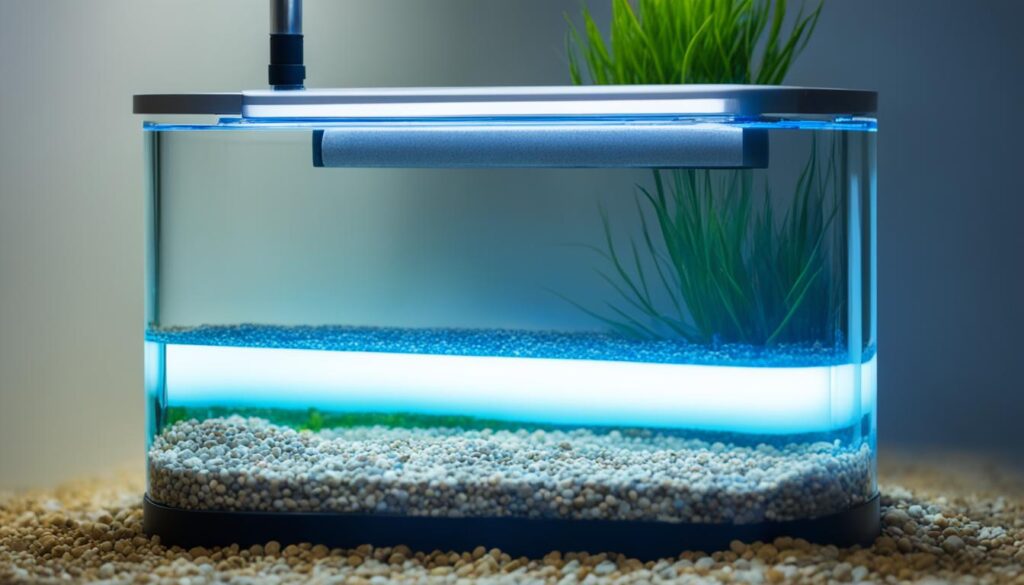
With the right equipment in place, you’ll be one step closer to creating a thriving shrimp tank that will bring joy and beauty to your home.
Water Parameters for Freshwater Shrimp
When keeping freshwater shrimp in your aquarium, it is crucial to understand their specific water parameter requirements. Different species of shrimp, such as Neocaridina and Caridina, have distinct preferences when it comes to ideal water conditions.
Neocaridina shrimp, including popular varieties like Red Cherry Shrimp, can tolerate a wide range of water parameters. They thrive at temperatures between 65°F-84°F and prefer a pH level ranging from 6.5 to 8.0. These hardy shrimp species can adapt well to various water conditions, making them an excellent choice for beginners.
On the other hand, Caridina shrimp, such as Crystal Red Shrimp, have stricter water parameter requirements. They prefer cooler temperatures, typically ranging between 64°F-76°F, and tend to thrive in slightly lower pH levels of 6.0 to 7.5. Maintaining stable and appropriate water conditions within these ranges is crucial for the health and well-being of Caridina shrimp.
To ensure the optimal health of your freshwater shrimp, it is essential to regularly monitor and maintain the water parameters in your aquarium. This includes regularly testing the temperature and pH levels, and making necessary adjustments to keep them within the preferred ranges for your specific shrimp species.
| Parameter | Neocaridina Shrimp | Caridina Shrimp |
|---|---|---|
| Temperature Range | 65°F-84°F | 64°F-76°F |
| pH Level | 6.5-8.0 | 6.0-7.5 |
It is important to provide stable and appropriate water conditions for your freshwater shrimp. By understanding their specific water parameter requirements and diligently maintaining those conditions, you can ensure the well-being and thriving of these fascinating aquatic creatures in your aquarium.
Feeding and Diet of Freshwater Shrimp
Freshwater shrimp, like most shrimp species, have a diverse and omnivorous diet. Providing them with a balanced and nutritious diet is essential for their health and overall well-being.
1. Algae and Biofilm:
Algae and biofilm are natural food sources for freshwater shrimp. They graze on the biofilm that develops on surfaces within the tank, such as rocks and plants. Algae can also provide essential nutrients for shrimp, and cultivating a healthy amount of algae in the tank can contribute to their diet.
2. Plant Matter:
Shrimp also consume plant matter as part of their diet. They will nibble on decaying leaves, soft plant tissue, and even certain types of aquarium plants. Including live or artificial plants in the tank can serve as a food source for the shrimp and enhance their natural foraging behavior.
3. Commercial Shrimp Food:
Supplementing the natural diet of freshwater shrimp with commercial shrimp pellets or flakes is recommended. These specialized foods are formulated to meet the specific nutritional requirements of shrimp. They usually contain a combination of plant matter, proteins, vitamins, and minerals that support the growth and health of the shrimp.
It is important to feed shrimp appropriate amounts to prevent overfeeding, which can lead to poor water quality and health issues. Monitor their feeding habits and adjust the amount of food accordingly, taking into consideration the number of shrimp in the tank.
Regular monitoring of the shrimp’s feeding behavior and overall health is crucial. If you notice any changes in their appetite or appearance, it may indicate a need to adjust their diet or address potential health issues.
Remember, a balanced diet that includes a combination of natural food sources and commercial shrimp food is key to maintaining optimal health and growth for your freshwater shrimp.

| Dietary Source | Description |
|---|---|
| Algae and Biofilm | Natural food sources found in the tank, including biofilm and algae. Shrimp graze on these surfaces to feed. |
| Plant Matter | Decaying leaves, soft plant tissue, and certain types of aquarium plants that provide additional food and foraging opportunities for shrimp. |
| Commercial Shrimp Food | Specialized pellets or flakes formulated to meet the nutritional needs of shrimp, containing plant matter, proteins, vitamins, and minerals. |
Breeding Freshwater Shrimp in Small Tanks
Breeding freshwater shrimp in small tanks can be an exciting and rewarding endeavor. Whether you have Neocaridina or Caridina shrimp species, understanding their unique breeding behaviors and requirements is key to successful reproduction. Neocaridina shrimp, such as the popular Red Cherry Shrimp, are known for their higher breeding rates and adaptability, making them ideal for beginners. On the other hand, Caridina species like the exquisite Crystal Red Shrimp require more precise care and specific water parameters to thrive.
To increase your chances of successful shrimp breeding in a small tank, it is crucial to create a suitable breeding environment. Here are some essential tips:
1. Maintain Stable Water Conditions:
Consistency is essential when breeding freshwater shrimp. Monitor and maintain proper water parameters for your shrimp species, including temperature, pH levels, and water hardness. Keeping these conditions stable will provide a favorable environment for breeding.
2. Provide Hiding Places:
Shrimp, especially females, require hiding places to feel secure during the breeding process. Incorporate vegetation, decorations, and breeding caves into your tank design to give them ample hiding spots.
3. Offer a Varied Diet:
A well-rounded diet is crucial for successful shrimp breeding. Provide a mix of high-quality shrimp pellets, algae wafers, and blanched vegetables for balanced nutrition. Additionally, feeding your shrimp a calcium-rich diet can promote healthy molting and reproduction.
4. Separate Maturing Shrimp:
As shrimplets mature, they become vulnerable to predation by adult shrimp. It’s important to separate the young from adults to ensure their survival. Utilize a breeder box or invest in a separate tank for the young shrimplets until they reach a size where they can safely join the main tank.
| Shrimp Species | Neocaridina | Caridina |
|---|---|---|
| Temperature | 65°F – 84°F | 64°F – 76°F |
| pH Levels | 6.5 – 8.0 | 6.0 – 7.5 |
| Water Hardness | ~2 – 15 dGH | ~4 – 6 dGH |
| Difficulty Level | Easy to Moderate | Moderate to Difficult |
By understanding the specific breeding habits and requirements of your shrimp species, you can create an optimal environment that encourages successful breeding in your small tank. Enjoy the wonder of witnessing new generations of shrimp grow and thrive!
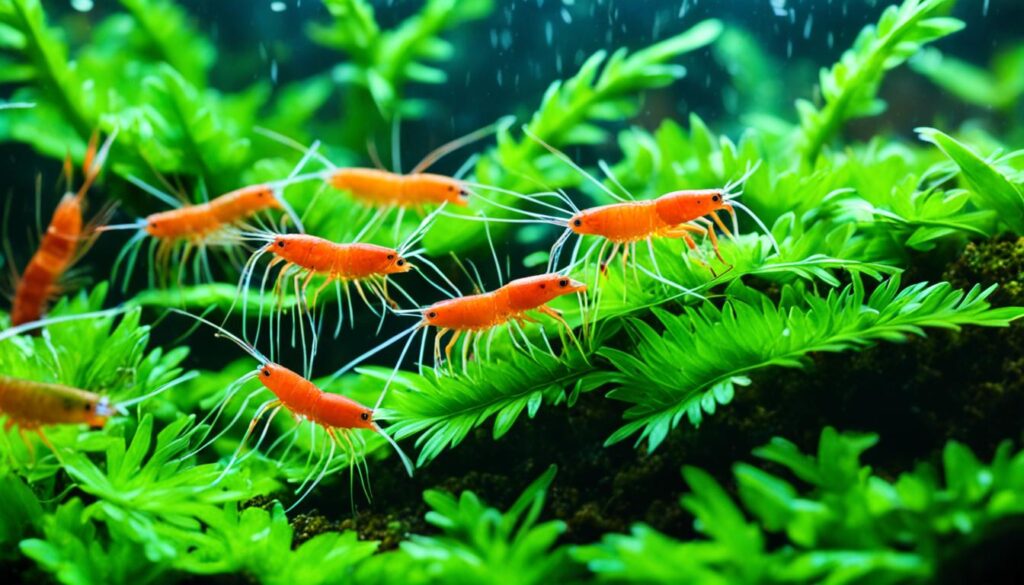
“Breeding freshwater shrimp in small tanks allows enthusiasts to witness the miraculous process of new life emerging. With careful attention to water conditions and the specific needs of your shrimp species, you can experience the joy of successful breeding.” – Shrimp Hobbyist
Tankmates for Freshwater Shrimp
When it comes to keeping freshwater shrimp in the same tank with fish, choosing the right tankmates is crucial for the safety and well-being of the shrimp. It’s important to select fish species that are compatible with shrimp and won’t pose a threat to them. Small, non-aggressive fish species are generally suitable tankmates for shrimp, providing a harmonious and peaceful cohabitation. Here are some examples of compatible fish for a shrimp tank:
- Small Tetras: Species like Neon Tetras (Paracheirodon innesi) and Ember Tetras (Hyphessobrycon amandae) are popular choices as tankmates for shrimp. They are peaceful and won’t harm the shrimp.
- Rasboras: Fish species like Harlequin Rasboras (Trigonostigma heteromorpha) or Chili Rasboras (Boraras brigittae) are small and gentle, making them suitable companions for shrimp.
- Dwarf Gouramis: Honey Gouramis (Trichogaster chuna) or Sparkling Gouramis (Trichopsis pumila) are calm and won’t harm shrimp. They add unique color and personality to the tank.
On the other hand, it’s important to avoid keeping aggressive or predatory fish that may harm or prey on the shrimp. These fish can create a stressful and unsafe environment. Always observe the interactions between the shrimp and tankmates closely. If any aggressive behavior is detected or if a fish starts targeting the shrimp, it’s crucial to separate them immediately to prevent any harm.
Quote:
Creating a peaceful and compatible community in your aquarium is not only visually pleasing but also crucial for the well-being of all the inhabitants, including the delicate freshwater shrimp. Choose tankmates wisely, ensuring a harmonious environment for everyone to thrive.
By carefully selecting compatible fish species as tankmates for your freshwater shrimp, you can create a captivating and diverse aquatic community. Remember to always consider the specific needs and behaviors of both shrimp and fish before introducing them to the tank. With the right combination of tankmates, you can provide a safe and enjoyable habitat for your freshwater shrimp.
| Fish Species | Compatibility with Freshwater Shrimp |
|---|---|
| Neon Tetras | Compatible |
| Ember Tetras | Compatible |
| Harlequin Rasboras | Compatible |
| Chili Rasboras | Compatible |
| Honey Gouramis | Compatible |
| Sparkling Gouramis | Compatible |
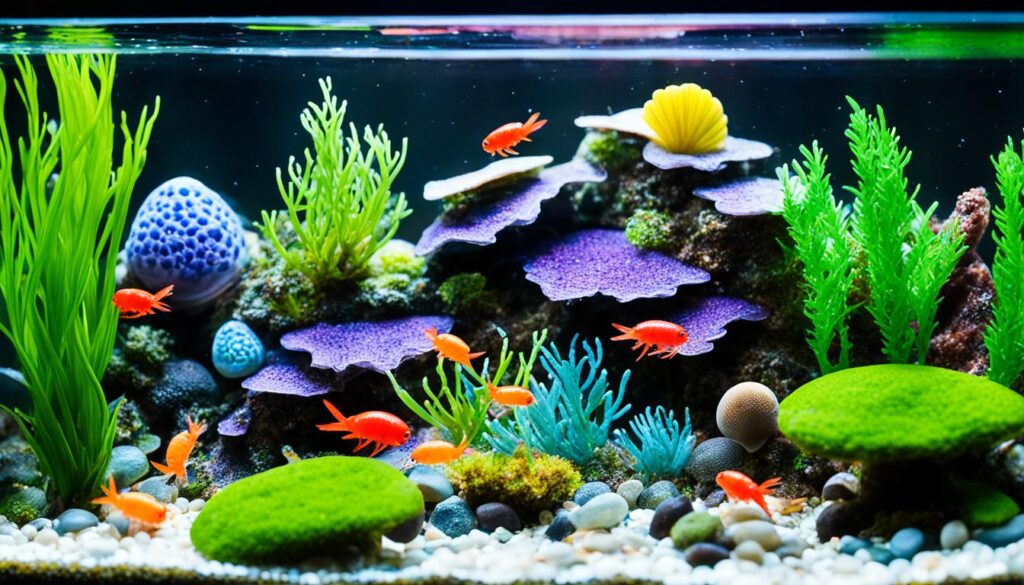
Additional Care Tips for Freshwater Invertebrates
When it comes to the care of freshwater invertebrates in small tanks, there are some general tips that can help ensure their well-being. In addition to the specific care needs mentioned earlier for freshwater shrimp, there are a few key considerations to keep in mind. By following these care tips, you can maintain a healthy and thriving environment for your invertebrates.
1. Regular Water Testing: Regularly test the water parameters of your tank to ensure they are within the appropriate range for your invertebrates. This includes checking the pH level, ammonia, nitrite, and nitrate levels. Keeping track of these parameters will help you detect any changes that may negatively impact the health of your invertebrates.
2. Water Changes: Performing regular water changes is essential for maintaining good water quality in your tank. This helps remove any accumulated toxins and keeps the water clean and clear. Aim to change around 25% of the water every week or as needed, depending on the size and stocking level of your tank.
3. Proper Tank Maintenance: In addition to water changes, ensure that you regularly clean and maintain your tank. This includes cleaning the glass, removing any uneaten food or debris, and trimming any overgrown plants. A clean and well-maintained tank is vital for the overall health and longevity of your invertebrates.
4. Avoid Sudden Changes: Invertebrates, such as shrimp, are sensitive to sudden changes in water parameters and temperature. Avoid rapid fluctuations in these conditions, as they can cause stress and potentially harm your invertebrates. Make any changes gradually and monitor their behavior and appearance for any signs of distress.
5. Monitor Behavior and Appearance: Keep a close eye on the behavior and appearance of your invertebrates. Look for any changes in their feeding habits, movement patterns, or coloration. These can be indications of stress, illness, or other issues. Being proactive in monitoring their well-being allows you to address any problems promptly.
6. Seek Expert Advice: If you encounter any issues or have questions about the care of your freshwater invertebrates, don’t hesitate to seek advice from experts or experienced hobbyists. They can provide valuable insights and guidance based on their knowledge and experience with these creatures.
“Proper care and maintenance are essential for the well-being of freshwater invertebrates in small tanks. By following these care tips and providing a suitable environment, you can ensure that your invertebrates thrive and bring beauty to your aquarium.”
Remember, each species of freshwater invertebrates may have specific care needs, so it’s important to research and understand the requirements of the particular species you intend to keep. By following these general care tips and tailoring them to your specific invertebrate species, you can create a healthy and thriving environment for your small tank invertebrates.
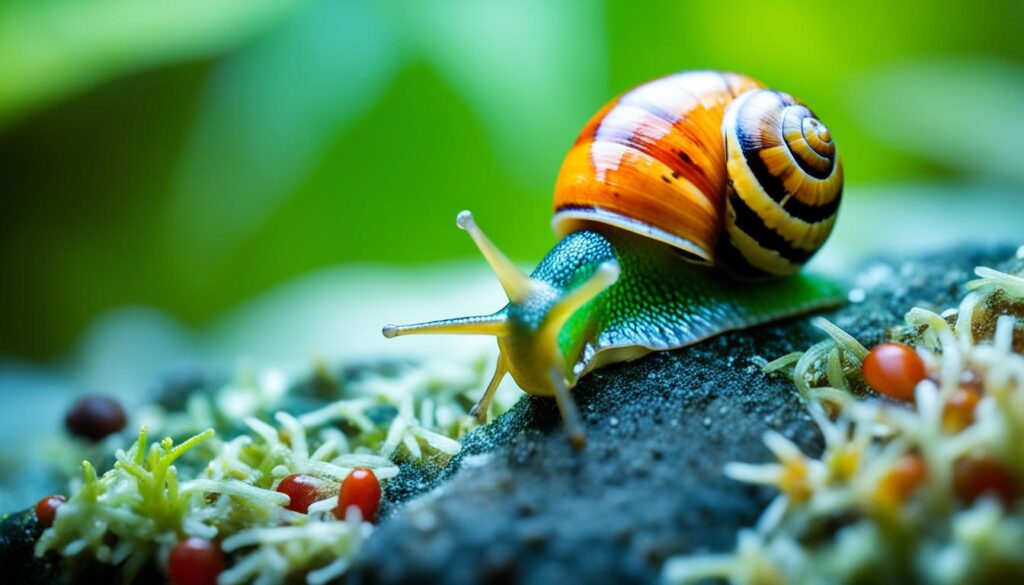
Conclusion
After considering the needs and compatibility of freshwater invertebrates, it is clear that careful selection and proper care are essential for their well-being. Different species of fish and shrimp have specific water parameter requirements and behaviors that must be taken into account when creating a suitable environment. Providing the appropriate equipment, maintaining proper water conditions, and offering a balanced diet are crucial for their health.
With the right care and attention, freshwater invertebrates can thrive and enhance the beauty of small aquarium setups. Whether it’s the vibrant colors of freshwater dwarf shrimp or the graceful movements of other invertebrates, they can create a captivating and dynamic underwater world. By focusing on their specific needs and creating an optimal environment, you can enjoy the unique charm and diversity that freshwater invertebrates bring to your aquarium.
Remember, continual monitoring of their behavior, appearance, and water parameters is important to ensure any signs of stress or illness are detected early. Regular maintenance, such as water testing and water changes, is essential to maintain their health. If you encounter any challenges or have questions, it’s always beneficial to seek advice from experts or experienced aquarists who can provide guidance based on their knowledge and experience. By following these guidelines and showing the necessary care, you can successfully keep freshwater invertebrates in small tanks and enjoy their presence for years to come.
FAQ
How do I choose freshwater invertebrates for small tanks?
When choosing freshwater invertebrates for small tanks, it is important to consider their specific needs, including water parameters, compatibility with other tank inhabitants, and suitable tankmates.
What should I consider when choosing fish for a small tank?
When choosing fish for a small tank, consider factors such as their potential size, compatibility with other tank inhabitants, territorial behavior, dietary requirements, and water parameters. Researching and understanding the specific needs of fish species will help you select the best fish for your small tank.
What are the seven categories of aquarium fish?
The seven categories of aquarium fish are catfish, characiforms, cichlids, cypriniforms, cyprinodonts, labyrinth fish, and rainbowfish. Each category includes a variety of fish species with different traits and characteristics.
Can I keep freshwater dwarf shrimp in small tanks?
Yes, freshwater dwarf shrimp can be a great addition to small tanks. They are low-maintenance and can cohabitate with fish or be kept in shrimp-only tanks. Neocaridina and Caridina are the two main genuses of freshwater shrimp suitable for small tanks.
What equipment do I need to set up a shrimp tank?
When setting up a shrimp tank, you will need a tank of appropriate size, a filter (such as a sponge filter or hang-on-the-back filter), a heater (if needed), substrate (such as sand or gravel), hardscape elements like driftwood and rocks, and live aquatic plants.
What are the water parameter requirements for freshwater shrimp?
Different species of freshwater shrimp have specific water parameter requirements. Neocaridina shrimp can tolerate a wide range of water parameters, including temperature ranges of 65F-84F and pH levels of 6.5-8.0. Caridina shrimp prefer cooler temperatures around 64F-76F and lower pH levels of 6-7.5.
What do freshwater shrimp eat?
Freshwater shrimp are omnivorous and have varied dietary needs. They can feed on algae, biofilm, plant matter, and commercial shrimp pellets or flakes. It is important to provide a balanced diet for the shrimp, including both natural and supplemental foods.
How do I breed freshwater shrimp in a small tank?
Breeding freshwater shrimp in small tanks can be a rewarding experience. Neocaridina species are known for their higher breeding rates and ease of reproduction. Caridina species have more specific breeding needs and may require specific water parameters or specialized breeding setups.
Can freshwater shrimp be kept with other fish in the same tank?
Yes, it is possible to keep freshwater shrimp with certain fish species in the same tank. However, it is important to choose compatible tankmates that are small and non-aggressive to ensure the safety and well-being of the shrimp.
What are some additional care tips for freshwater invertebrates in small tanks?
Regular water testing, water changes, and proper tank maintenance are essential for maintaining the health and well-being of freshwater invertebrates. Avoid sudden changes in water parameters or temperature that may stress the invertebrates. Monitor their behavior and appearance closely to detect any signs of illness or stress.
